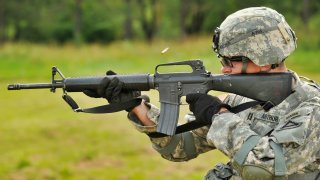M16: Why Are There So Many Different Versions of This Rifle?
The M16A2 and M16A3 variants differ mainly in their firing modes, with the A3 offering fully automatic fire. The M16A2's three-round burst mode helps conserve ammunition and maintain consistent fire during squad operations.
Summary: In my commentary comparing the M16 to the M4 carbine, I express a preference for the M16 due to its longer barrel, which enhances long-range accuracy.

My familiarity with the M16, having first trained with it in the military, also plays a role in this preference.
Despite qualifying on the range with both weapons, the M16 felt more comfortable, especially for someone with longer arms.
The M16A2 and M16A3 variants differ mainly in their firing modes, with the A3 offering fully automatic fire. The M16A2's three-round burst mode helps conserve ammunition and maintain consistent fire during squad operations.
The M16A2 and M16A3: Key Differences Explained
You may have read my previous commentary about the M16 versus the M4 carbine and why I prefer the M16 over the M4. I like the elongated barrel of the M16 for better long-range marksmanship.
It was the first military rifle I trained with, so I like the familiarity. Shooting the M4 came about when I was an infantry officer after originally enlisting as a military journalist. (I know, insert joke here about that MOS).
But I had to qualify at the range like every soldier and the M16 just felt better, especially for someone like me with longer arms that makes the smaller carbine feel different.
There Are Different Types of M16s
You may not know the M16 has different variants. For the purposes of this article, I will stick to describing the M16A2 versus the M16A3. (The M16A4 has a Picatinny rail for accessories). The major difference between the A2 and A3 variants is that the M16A3 has a fully-automatic mode, while the M16A2 has a three-round burst mode instead of fully automatic.
What Is a STX Lane?
I once had an M-16A3 that I used in situational training exercises – a practice lane with opposing force soldiers that are guarding objectives. We were firing our weapons with MILES gear (Multiple-Integrated Laser Engagement System) to heighten realism. This is like laser tag on steroids. The M16A3 was fun to shoot in automatic mode, but it drains your magazine fast. I once had an observer-controller scold me for wasting ammunition while firing indiscriminately on fully auto mode. I was likely downgraded on my evaluation form for making this mistake. But it is easy to go through your ammo fast and wasting it is unsatisfactory.
Volleying Fire With the M16A2
The M16A2 has the three-round burst selection. So, the selector is “safe-semi-three round burst.” This comes in handy at the squad level because you can volley the fire so that all your squad mates do not run out of ammunition at the same time. When you have one soldier on semi-auto and another on three-round burst you can keep the fire level consistent while people re-load at different times.
When the M16A2 Replaced the M16A1
While there are no major differences between the M16A2 and A3 besides the fire mode, there were many improvements with the advent of the M16A2 in the 1980s based on experience from the Vietnam War. The M16A2 has a thicker barrel than the M16A1. The flash suppressor was changed to keep the rifle from kicking up dust when soldiers or marines fired from the prone position. The rear sight became adjustable to enable different settings depending on distance and windage.

The front grip was rounded instead of triangular. The handguards were the same. The grip was enhanced. The butt stock was made of sturdier materials and lengthened by 5/8ths of an inch.
The three-round burst mode was seen as a way to better conserve ammunition and increase accuracy. Tracer rounds at night could better guide a soldier to his or her target. The fully-automatic A3 was not used beyond the Navy SEALs and other navy units. The A2 served many soldiers and marines well during Operation Desert Storm.
The Type of M16 Used Depending on the Era You Served
When I enlisted in the Army in 1999, we used the A2, and then I had familiarity with the A3 fully automatic in officer training. In 2001, I switched to the M4 and had my first experience with the rail system and the close combat optic. I always said the M16A2 should have been included in each squad in a rifle platoon for long-range shots. The Army has now developed the Designated Marksman rifle to address the need for a longer range than the M4 provided. Soldiers and marines who served before 9/11 may remember the M16A2 as the first and only military weapon they ever fired.
Expert Biography
Dr. Brent M. Eastwood is the author of Humans, Machines, and Data: Future Trends in Warfare. He is an Emerging Threats expert and former U.S. Army Infantry officer. You can follow him on Twitter @BMEastwood. He holds a Ph.D. in Political Science and Foreign Policy/ International Relations. Email the author: [email protected].
All images are Creative Commons.


